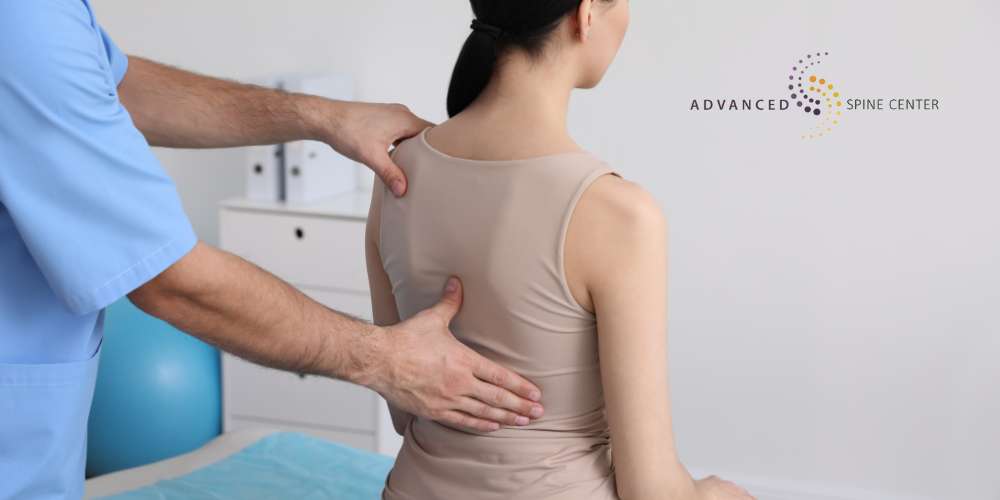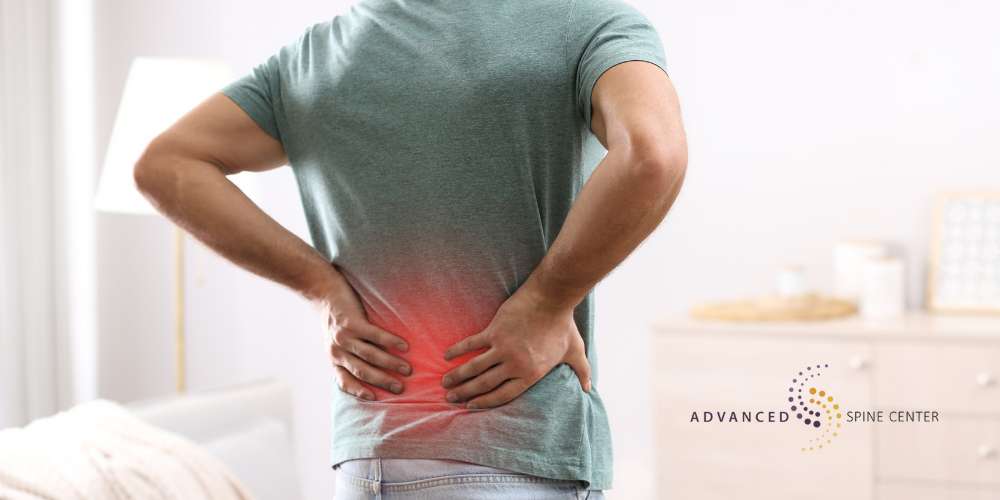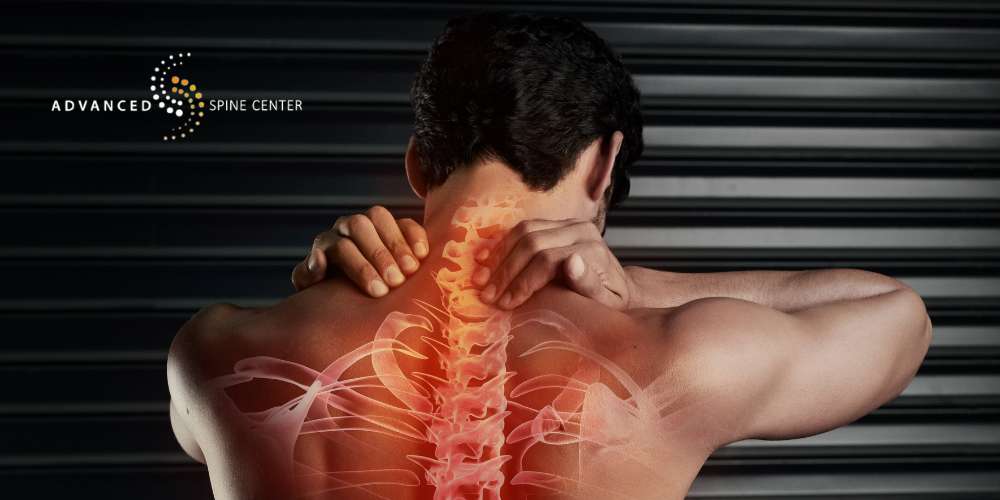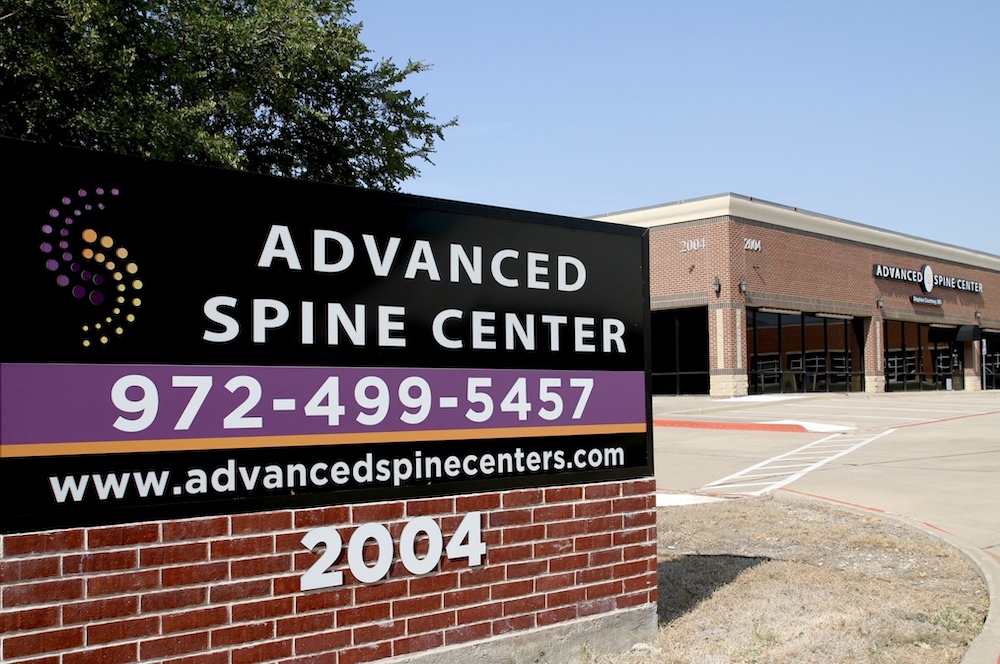Specialties

If you are looking for professional spinal stenosis treatment in Plano, TX, look no further than Advanced Spine Center. We are proud to help the residents of Northeast Texas and beyond find relief from spinal injuries, degenerative conditions, and spinal dysfunction, allowing them to live their lives free of pain.
Spinal stenosis is a condition in which the spinal canal narrows, putting pressure on the spinal cord and other spinal nerves. We offer a variety of treatments for spinal stenosis, and can help you find a treatment plan that works for you. Led by Dr. Stephen Courtney, our clinic is here to help provide you with a personalized treatment plan designed to relieve pain and help you regain mobility in your spine.
Take the first step toward a pain-free life. Contact Advanced Spine Center today to schedule a consultation and learn more about our cutting-edge treatments for spinal stenosis. Call (972) 499-5457 to schedule your appointment with us today.
What Is Spinal Stenosis?
Spinal stenosis is a condition where the spaces within your spinal column narrow, which can put pressure on the spinal cord as well as the nerve roots that extend out from the spinal column. The type of spinal stenosis depends on the location of the nerve compression. This narrowing can occur in the cervical (neck), thoracic (mid-back), or lumbar (lower back) regions. Below are some of the most common types of spinal stenosis.
Cervical Spinal Stenosis
Cervical spinal stenosis is a condition where the spinal canal in the neck region narrows, putting pressure on the spinal cord and nerves in that region of the spine.
Lumbar Spinal Stenosis
Similarly, lumbar spinal stenosis is the narrowing of the spinal canal in the lower back, which can compress the nerves in the lumbar spine.
Spinal Stenosis Symptoms

Symptoms of spinal stenosis include pain, numbness, tingling, and muscle weakness in certain areas of the body, depending on the location of the stenosis. Below are some of the more specific symptoms associated with different types of spinal stenosis.
If you notice that you’re experiencing any of these symptoms, you may want to have spinal stenosis diagnosed by a medical professional. This is usually done through a comprehensive patient history, physical exam, and through diagnostic testing like nerve blocks, magnetic resonance imaging (MRI) scans, and CT scans.
Cervical Spinal Stenosis Symptoms
Symptoms of cervical stenosis include neck pain, numbness or tingling in the arms and hands, weakness in the arms and hands, difficulty with coordination and fine motor skills, and, in severe cases, problems with balance and walking.
Lumbar Spinal Stenosis Symptoms
Specific symptoms of lumbar spinal stenosis include lower back pain, numbness or tingling in the legs or feet, weakness in the legs, difficulty walking or standing for extended periods, and leg pain or cramping that is relieved by sitting or bending forward. In extreme cases, it can even result in loss of bowel or bladder control.
What Causes Spinal Stenosis?
Spinal stenosis is primarily caused by age-related changes in the spine, such as the degeneration of spinal discs and the thickening of ligaments, like the ligamentum flavum. Other causes include osteoarthritis, which can lead to the formation of bone spurs that narrow the spinal canal, herniated discs that protrude into the canal, and congenital spinal defects. Injuries and conditions like scoliosis can also contribute to the development of spinal stenosis.
What Is Considered Severe Spinal Stenosis?
Severe spinal stenosis is characterized by significant narrowing of the spinal canal that results in substantial compression of the spinal cord or nerve roots. This condition can cause intense pain, pronounced weakness, and severe numbness in the affected areas. It may also lead to significant functional impairment, such as difficulty walking, loss of bladder or bowel control, and severe balance problems.
Spinal Stenosis with Neurogenic Claudication
Spinal stenosis with neurogenic claudication occurs when the narrowing of the spinal canal compresses the nerves, causing pain, cramping, and weakness in the legs, particularly when standing or walking. These symptoms are typically relieved by sitting or bending forward, which reduces pressure on the affected nerves. Neurogenic claudication is a hallmark symptom of lumbar spinal stenosis.
Spinal Stenosis Treatment in Plano, TX

At Advanced Spine Center in Plano, TX, we offer a range of advanced treatment options for spinal stenosis tailored to meet the unique needs of each patient. Our comprehensive approach includes non-surgical interventions such as medication management, specialized physical therapy programs, and targeted exercises.
For those requiring surgical intervention, our skilled orthopedic surgeons provide state-of-the-art spine surgery procedures like laminectomy and spinal fusion to relieve nerve compression and restore spinal stability effectively.
Spinal Stenosis Surgery in Plano, TX
We at Advanced Spine Center are proud to offer comprehensive spinal stenosis surgery options to our patients. Our surgical options include laminectomy procedures, which involve removing part of the vertebra to create more space for the spinal cord and spinal nerves.
We also provide cervical fusion surgery and lumbar fusion surgery, which stabilize the spine by joining two or more vertebrae together. These procedures aim to relieve nerve compression, reduce pain, and restore mobility.
Our experienced orthopedic surgeons utilize advanced techniques to ensure precise and effective treatment, helping you regain function and resume your daily activities with less discomfort.
Spinal Stenosis Surgery Recovery
Recovery from spinal stenosis surgery varies based on the specific procedure performed and individual health factors. Generally, patients may expect to stay in the hospital for a few days, and will have their activities restricted for a period after they are sent home. They will also likely be asked to attend physical therapy to help them regain strength and mobility in their back.
Over time, the pain and discomfort gradually diminish as the surgical site heals and the spine stabilizes. It may take patients several weeks to a few months before they can return to regular exercise and daily activities.
How Do You Fix Spinal Stenosis Without Surgery?

In addition to surgeries designed to treat spinal stenosis, there are also a number of nonsurgical treatments that can help relieve pressure on the spinal nerves and reduce pain. Alternative treatments for spinal stenosis include medications, physical therapy, and certain exercises.
Spinal Stenosis Medication
Medications such as nonsteroidal anti-inflammatory drugs (NSAIDs), acetaminophen, or oral steroids may help alleviate pain and relieve inflammation associated with spinal stenosis. In some cases, muscle relaxants or neuropathic pain medications may be prescribed to manage symptoms like muscle spasms or nerve pain.
What Is the Best Painkiller for Spinal Stenosis?
Some argue that the best painkiller for spinal stenosis is an NSAID like ibuprofen or naproxen, but it depends on the patient’s preferences and individual needs. Other medications like muscle relaxants and tricyclic antidepressants can also provide significant pain relief and help manage symptoms.
Spinal Stenosis Physical Therapy
Physical therapy plays a crucial role in treating spinal stenosis by focusing on exercises and stretches that improve flexibility, strength, and posture. The patient’s physical therapist may also use techniques like manual therapy and traction to relieve pressure on the spine and enhance mobility.
Spinal Stenosis Exercises
Specific exercises can help relieve symptoms of spinal stenosis by strengthening the muscles that support the spine and improving flexibility. Exercises such as gentle stretching, low-impact aerobic activities like walking or swimming, and core strengthening exercises can help alleviate pain and discomfort.
Spinal Stenosis FAQs
What Is the Treatment for Spinal Stenosis in Elderly Patients?
Treatment for spinal stenosis in elderly patients typically begins with conservative measures such as pain medications, physical therapy to improve strength and flexibility, and specific exercises tailored to their mobility and health status.
If symptoms persist or worsen, minimally invasive surgery options may be considered to alleviate nerve compression and improve quality of life.
Is Spinal Stenosis Hereditary?
Spinal stenosis can have a hereditary component, as genetic factors may contribute to the development of conditions like osteoarthritis or congenital spinal abnormalities that can lead to spinal stenosis. However, lifestyle factors such as occupation, physical activity levels, injuries, herniated disks, and age-related changes in the spine also play significant roles in spinal stenosis.
Is Spinal Stenosis a Permanent Disability?
Spinal stenosis can lead to varying degrees of disability depending on the severity of symptoms and individual response to treatment. While some people may experience persistent symptoms that significantly impact daily life, others may find relief through various treatment options.
Disability determination typically considers the extent of functional limitations caused by spinal stenosis and how they affect activities of daily living and work.
Who Treats Spinal Stenosis?
Spinal stenosis is typically treated by healthcare providers specializing in orthopedics or neurosurgery, like the spinal professionals at Advanced Spine Center in Plano, TX. We treat a variety of spinal conditions, including spinal stenosis, and offer patients a variety of treatment options.
Can Spinal Stenosis Kill You?
In general, no, spinal stenosis itself is not typically life-threatening and will not result in death. However, severe cases where the spinal cord is significantly compressed can lead to complications such as loss of bladder or bowel control, which may necessitate urgent medical attention. In rare instances, untreated severe spinal stenosis could potentially lead to paralysis or other serious neurological deficits.
Contact the Advanced Spine Center for Spinal Canal Stenosis Treatments in Plano, TX

Contact Advanced Spine Center in Plano, TX, today to explore our comprehensive treatments for spinal canal stenosis tailored to your unique needs. Our orthopedic surgeons and healthcare professionals are dedicated to providing patients with personalized care, ensuring they receive the treatments they need and deserve.
Whether you’re seeking relief from spinal stenosis symptoms, have a herniated disk, or simply want to leave your chronic pain behind, call the spinal professionals at Advanced Spine Center today. Call (972) 499-5457 or fill out our online contact form to schedule an initial appointment with a member of our medical team.


